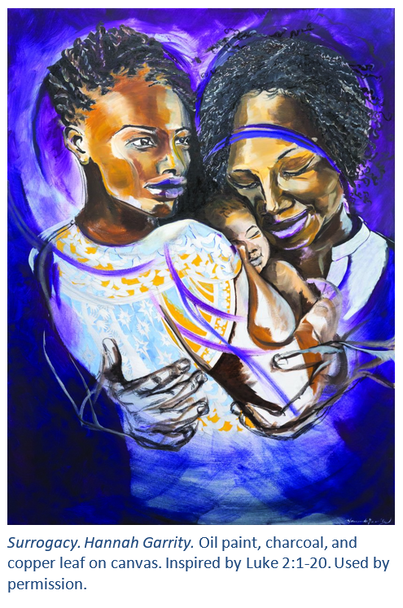 What was achieved in the body of Mary will happen in the soul of everyone who receives the Word. ~ St. Gregory of Nyssa, 4th century There is something about Christmas Eve and its worship. It is a comfortable space for many, and many of us—especially in times of such upheaval, in times of weariness—crave the familiarity and company of tradition. Those carols and hymns that ring with such strong affirmation, that hold us in the deep, in the mystery and awe of (in the Northern hemisphere) our longest nights. When it is hard to see with our eyes, we long to look to our memories and our stories for visions of what holds us. How does a weary world rejoice? We make room. We make room for memory. We make room for new life. We make room for family. We make room for one another. We make room for all who wander and wonder looking for home. Enter into worship this Christmas Eve. Readings: Isaiah 61:1-4, 8-11 † Psalm 126 † Luke 1:57-66 About the art: Surrogacy. Hannah Garrity. Oil paint, charcoal, and copper leaf on canvas. Inspired by Luke 2:1-20. Used by permission.
From the artist:
Dr. Christena Cleveland published a book in 2023 called, God is a Black Woman.5 In it, she shares her powerful testimony describing her journey to meet the Black Madonnas carved centuries ago from lava rock. This resonates with my lifelong yearning for Mother God. Male language for God has always been a wall to my ability to connect in worship. Now, it is a wall that I break through every week—changing words, rewriting liturgy in the moment, saying “Mother” where “Father” is printed, trying “Lady” where “Lord” is printed. In this case, “Yahweh” is actually best. Who are we to squash God into patriarchy so perpetually? But when someone else joins me in this necessary work, that is when the barrier is removed. I hear it sometimes: “She,” “Mother.” Almost always, the liturgist feels the need to explain themselves. In liturgy discussion, gaslighting is common. “We should be more inclusive.” All of a sudden? Recently, I was standing at The Dwelling at Richmond Hill.6 The former slave quarters are open and offered for visitation. After our tour, the idea that one should remove their shoes before entering this holy haven came up. Our tour group was all white people and we discussed this idea from a theoretical standpoint. But earlier, before we entered, I felt it. I was holding a seltzer water can from lunch and felt incredibly rude entering the space with it, so, without understanding, I backtracked and placed my purse and the can outside. I knew not why. After the tour, in our discussion about shoes, our white tour guide mentioned that Black members of the staff felt a great reverence, a holy presence at The Dwelling. The space held the presence of God; it was like entering a sanctuary. I remember the same feeling when I was young, touring the slave quarters at Monticello. But now, listening to the Richmond Hill staff testimony, I understood these spaces in a new way, with a reverence for the God-like presence of the Black mother in the depths of oppression. “Listen to Black women.” This cry has become a mantra over the last few years. I saw in that moment what Cleveland so eloquently explains in her book. In the pigmentocracy we inhabit, the Black mother is the closest figure to God, and “whitemalegod” is the very farthest. He promotes oppression; She is the savior of the most oppressed. And so I listen. In this painting, Black Mother God has asked her daughter Mary to hold the role of surrogate for the pregnancy of infant Creator. Mary has carried the child to term. She has given birth. God embraces Mary as well as the Holy Infant in gratitude. For without Mary’s surrogacy, the incarnation could not be.
0 Comments
Leave a Reply. |
worshipYou'll find here links to weekly worship and, where applicable archived service videos. Archives
July 2024
Categories |
 RSS Feed
RSS Feed